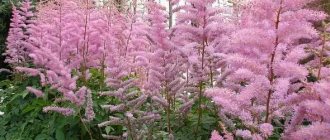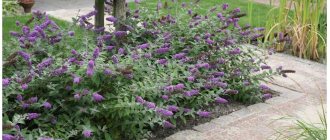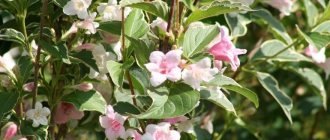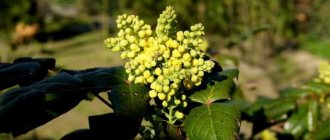Surely everyone at least once in their life has come across this spectacular and at the same time delicate shrub with the funny name “vesicle”. A description of the varieties of this plant is in our material.
About 14 species of this ornamental deciduous shrub are known. The genus Physocarpus has been grown in our latitudes since 1793 (first mention in the catalogs of the St. Petersburg Botanical Garden). Currently, lush bushes of different varieties of bladderwort can be found not only in home gardens, but also in city parks.
This is an unpretentious, frost-resistant shrub. Often, bladderwort is used as a hedge, planting bushes along railway lines.
What is remarkable about the yellow-leaved bladderwort
This plant is a deciduous shrub and belongs to the small Rosaceae family. The culture got its name due to the swollen fruits that open at the top. The height of the bush reaches 1.5-3.5 m, depending on the variety.
Yellow bladderwort stands out not only for the color of its leaves, but also for its thick, lush crown. The leaf mass on the shoots is evenly distributed along the entire length, so the shrub looks three-dimensional. The plates are three- or five-lobed with a serrated edge and a rounded base. In appearance, they resemble viburnum or grape leaves.
During flowering, white-pink convex inflorescences with a diameter of 5-7 cm appear on the yellow vesicle. This period occurs in June-July and lasts 15-20 days. Each flower has many stamens, giving the appearance of a fluffy ball.
As a result, leaflet fruits are formed at the tops of the shoots, the color of which changes as they ripen. It is initially green, then red and eventually turns brown. This contrasting combination with yellow foliage increases the decorative value of the shrub.
Important! The yellow bladderwort begins to bloom and bear fruit 4-5 years after planting in a permanent place.
Fertilizers
Spring is the best time to lightly fertilize your bladderwort with compost and organic plant food formulated for shrubs and trees.
All that is required is one annual feeding. Apply fertilizer to the soil, starting a few centimeters from the trunk to where its branches end.
The best varieties of yellow-leaved bladderwort
There are several yellow species of this shrub. When breeding them, breeders pursued the goal of obtaining plants of compact size with contrasting leaf colors. But, despite the general qualities, each variety of golden vesicle has certain differences that you need to pay attention to when choosing to decorate a site.
Luteus
This variety is characterized by a lush, spreading bush that reaches a height of 2.5-3 m and a width of 4 m. But with regular pruning, you can get a dense crown, which will only improve the decorative qualities of the vesicle. The branches grow upward, but the ends droop slightly. The flowers are creamy white.
At the beginning of the growing season, the leaves of Luteus are rich yellow, with the onset of summer they acquire a light green tint, and in the fall they become crimson. The plates are decorated with a carved edging along the edge.
The shape of the leaves of the Luteus variety is very similar to grape leaves.
Gold Spirit
This variety of bladderwort is characterized by a yellow tint to the leaves. An adult plant is compact in size and reaches a height of no more than 2 m. It easily tolerates pruning and quickly grows a lush crown.
Important! The Gold Spirit variety retains a yellow tint of foliage from the beginning to the end of the growing season.
This variety of bladderwort looks impressive against the background of a green lawn
Nugget
This species was created thanks to the efforts of American breeders. The height of an adult vesicular carp reaches 2.5 m.
The leaves have a bright yellow color when they bloom, acquire a green tint closer to summer, and become golden again by autumn. The size of the plates is significantly smaller than that of other viburnum-leaved yellow vesicles. Nugget's flowers are white and cream.
Nugget differs from other species in its thick stems that grow exclusively upward
Aurea
This type of bladderwort is characterized by a hemispherical crown with spreading branches. The height of an adult plant reaches 3 m. The color of the leaves varies depending on the period of the year. In spring the shade is yellow, in summer it is greenish, and in autumn it is golden.
Aurea flowers are white, 1.2 cm in diameter, with numerous bright stamens. The fruits turn red when ripe.
Aurea shows the greatest decorative qualities when grown in an open sunny area.
Golden Nugget
The variety is characterized by enhanced shoot growth. An adult bush grows up to 2 m, while the diameter of the bush is also 2 m. The color of the leaves of the Golden Nugget, like many other types of bladderwort, changes throughout the season. Initially it is rich yellow, then becomes light green, and closer to autumn it acquires its original shade. The flowers of the Golden Nugget variety are white and pink with a pleasant, unobtrusive aroma.
The culture develops well in partial shade, but the leaves do not turn bright yellow.
Enis Gold
This variegated variety of bladderwort is distinguished by its compact bush size up to 2 m high and dense leafy crown. The color of the plates lasts throughout the season. The leaves are painted with yellow-green strokes, forming a peculiar pattern.
Despite the fact that Enis Gold is not characterized by a golden hue, this does not reduce its decorative qualities.
Enise Gold leaves are shaped like currants
Amber Jubilee
The variety was obtained by British breeders. An adult shrub of this variety does not exceed 1.5 m in height. The edge of the leaf blades is serrated. Their color is initially purple-yellow, then changes to green and turns orange at the end of the season.
The flowers are white, collected in hemispherical inflorescences, which look fluffy due to the numerous stamens.
Amber Jubilee was obtained by crossing Darts Gold and Diablo varieties
Darts Gold
A Dutch variety of bladderwort, characterized by a compact bush shape, the height of which reaches 1.5 m. The leaves of this species, when blooming, have a bright yellow color with an orange tint; with the arrival of the summer heat they become green, and in the fall they once again change their shade to crimson.
In June, white-cream corymbose inflorescences appear on the bush. Darts Gold is considered one of the most popular viburnum-leaved bladderworts with golden-hued foliage.
This hybrid was obtained by crossing varieties such as Luteus and Nanus
Angel Gold
This variety forms a bush 2-2.5 m high. Its branches grow vertically, slightly spreading. The leaves at the beginning of the growing season have a lemon-yellow tint, then become green in the summer, and in the fall they acquire their original shade. The plant is characterized by rapid growth.
The flowers of this species are white with a pink tint. The fruits ripen at the end of August and stay on the shoots for a long time, increasing the decorative qualities of the plant.
In the Angel Gold variety, by autumn a bright orange border or strokes in the center may appear along the edge of the leaf blade.
Description of the plant
This is mainly a shrubby species. Rarely reaching a height of more than 3 meters. But it can grow up to 4 meters or more in width. The leaves of the bladderwort look like the blades of a motorboat propeller. The texture is very similar to coltsfoot greens. The front side is dark green in color with a hard skin; the back side has padding resembling gray felt.
Like all shrubs, the viburnum-leaved bladdercarp bears fruit; its fruits have the appearance of swollen leaflets, which, when ripe, become reddish in color, which gives the plant a picturesque appearance.
Bladderwort viburnum flowers and fruits
The flowers also do not disappoint: they reach 15 millimeters in diameter, gathering together in single inflorescences of 10 - 15 pieces of umbrellas per branch. Most varieties have white flowers that bloom for about 20 – 25 days.
In addition to flowers, the shrub has leafy leaves, which in autumn can acquire a reddish tint or turn yellow. Plants in which the edges of the leaves acquire a golden color deserve special consideration.
Young shoots look like chestnut-colored shoots with smooth skin. As the bark matures, it acquires a rough structure that peels off in the form of longitudinal stripes.
The plant tolerates frost quite stably in winter. One of their characteristic features is resistance to all types of weather. Bladderwort easily tolerates dry soil and is absolutely not demanding of sunlight. It can be considered an ideal plant that requires virtually no care. Moreover, the average lifespan of a vesicular carp is about a quarter of a century, and it grows literally before our eyes, adding up to half a meter per year, reaching an “adult” height in three to four years.
The use of yellow bladderwort in design
According to the description, yellow bladderwort is a self-sufficient crop and looks great in single plantings against the background of conifers. But at the same time, it can also be combined with purple types of crops, using it as a hedge.
With the help of this plant you can divide the area into zones and decorate borders. The peculiarity of the bladderwort is that this plant does not suffer from exhaust gases and dust. Therefore, it can be used for landscaping city parks and squares, as well as creating a protective barrier from a nearby road.
Where can I buy?
You can buy bladderwrack seedlings in gardening stores and nurseries. You can also order by mail and through online stores.
| Variety | Where can I buy | Price |
| Diablo (40-60 cm) | Rosselkhoz nursery in St. Petersburg | 999 rub. |
| Luteus (40-60 cm) | Rosselkhoz nursery in St. Petersburg | 999 rub. |
| Red Baron (90 cm) | Nursery Kalina (Moscow region) | 450 rub. |
Video review Consultation from the Florist-X video channel.
Planting and caring for yellow-leaved bladderwort
This crop is undemanding to soil composition and can grow in one place for up to 40 years. The annual growth is about 40 cm in height.
It is necessary to place the vesicle in open sunny places, protected from drafts. With a lack of light, the color of the leaves will not be as bright as possible. The plant prefers loams with low or neutral acidity levels. When planting in a hole, you need to add a mixture of turf, humus and sand in a ratio of 2:1:1. Also, a layer of drainage 5-7 cm thick should be laid at the bottom, which will prevent moisture stagnation at the roots.
In the Angel Gold variety, by autumn a bright orange border or strokes in the center may appear along the edge of the leaf blade.
After this, sprinkle the roots with soil, compact the surface of the soil at the base and water generously. The next day, mulch the root circle with peat so that air can easily penetrate to the roots.
Important! Almost all types of yellow bladderwort do not tolerate stagnant moisture, so they need to be planted in well-drained soil.
When using the crop for hedges, seedlings should be planted in a checkerboard pattern, maintaining a distance of 45 cm, and row spacing should be left 35 cm wide.
In the future, it is necessary to monitor the soil moisture, avoiding drying out and waterlogging of the roots. In the absence of precipitation, watering should be done 1-2 times a week, depending on the air temperature and the rate of evaporation.
It is recommended to feed seedlings from 3 years of age. To do this, in the spring during the growing season, you should fertilize the plants with mullein 1:10 or chicken manure 1:20. And before winter, water with 40 g of superphosphate and 30 g of potassium sulfide per bucket of water.
To form a beautiful bush, yellow bladderwort needs to be pruned regularly, removing broken and damaged branches. In addition, if desired, the crown can be formed in the form of a ball, a cylinder, and also for a hedge in a straight line.
Once every five years it is recommended to carry out anti-aging pruning, removing all old shoots at the base
Advice! Adult bladderwrack bushes do not need shelter for the winter, and young seedlings up to three years old should be insulated with spruce branches or a cap made of roofing material should be made for them.
Planting a bush
Planting a bladderwort
The plant is completely unpretentious and tolerates both light and shadow. But in the latter case, the color of the leaves will be paler, so it is better to choose a place for planting that will be more exposed to sunlight.
The type of soil practically does not matter, but the most acceptable is the one that contains less lime and alkalis, in other words, the least oxidized soil. The plant tolerates air saturation with harmful gases well; creating a hedge along the road will be an excellent solution.
IMPORTANT
In order for the bladderwort to retain all its properties, it is not advisable to plant it from seeds. Only half of the offspring get the original color. Therefore, the best option would be to purchase seedlings in specialized shopping centers.
The instructions for planting viburnum vesicle are quite simple:
- A hole is dug, the depth of which does not exceed fifty centimeters.
- A peat cushion is used as drainage. You can add humus to it.
- It is advisable not to destroy the lump of earth with roots.
- After the plant is placed in the hole, it is covered with earth, but not compacted.
- The last step will be abundant watering. It is best to add trace elements containing potassium, manganese, phosphorus and molybdenum. One of the latest developments is the drug “Kornevin”. It improves the survival rate of almost any plant and is quite easy to use.
It is advisable to sprinkle the surface with sawdust after planting. They will prevent excessive moisture removal and prevent weeds from destroying the young plant. They will not allow beneficial substances to “bleed away” from the soil.
Video - instructions “How to plant viburnum leaf carp”
Features of reproduction
Yellow bladderwort can be propagated in different ways. If you need to get a small number of new seedlings, you can use layering or divide an adult bush.
In the first case, you need to select a strong lower shoot in early spring, bend it to the ground and lay it in a ditch 10 cm deep. In this case, the top should remain on top. Regular watering is required throughout the season. With proper care, the shoot will take root by autumn. Then it can be disconnected from the queen cell.
In the second case, getting new seedlings of yellow bladderwort will not be difficult even for a novice gardener. To do this, you need to dig up the mother bush in early spring or autumn. Divide it into parts with sharp pruning shears so that each division has several shoots and well-developed root processes. After this, plant them in a permanent place.
It is recommended to divide the yellow bladderwort bush in the spring before the growing season or in the fall after leaf fall
Pests and diseases
Yellow bladderwort is highly resistant to pests and diseases. But if the soil is excessively moistened, the bush can be affected by powdery mildew. It is recognized by a white coating on the leaves, which later turns brown. The disease interferes with the process of photosynthesis and causes premature leaf fall.
To eliminate powdery mildew, it is necessary to treat the bush with any of the proposed means:
- "Skor";
- "Bayleton";
- "Fundazol";
- "Topaz".
If there is a lack of nutrients, yellow bladderwort may suffer from chlorosis. A characteristic feature of the disease is discoloration of the leaf blade with clearly visible veins on it. To eliminate chlorosis, it is recommended to water the bushes 2-3 times with the working solution of the drug “Ferovit”.











